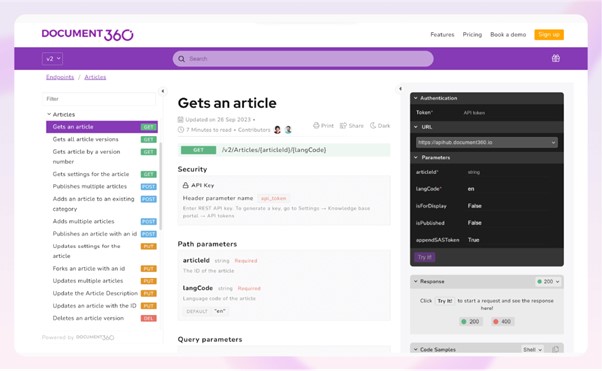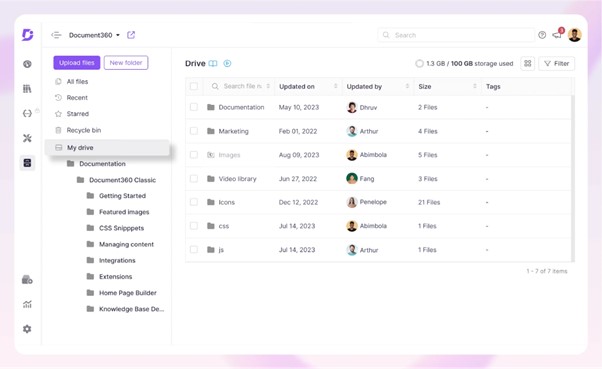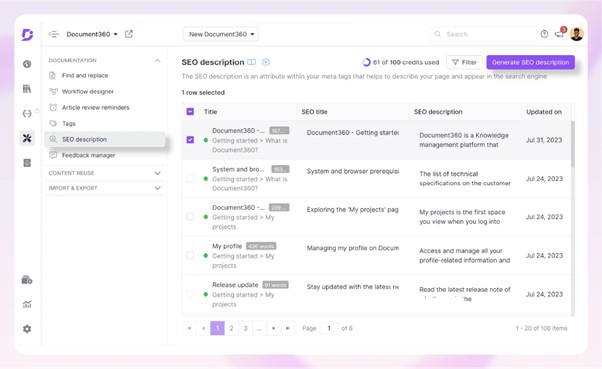When working on creating documentation, as technical writers do you still face challenges in maintaining consistency, style, collaboration, and version control? If you are nodding your head, then have you thought about implementing the right tool?
That’s why structured authoring tools are a top consideration for content teams that need to create documentation for their users, working at scale to produce helpful technical documentation with the latest technical writing tools.
Although the market is large and there are many useful tools for documentation, structured authoring tools hold a special place because they are specifically designed for technical teams producing large amounts of documentation. Working without structured authoring tools can lead to many inefficiencies and wasteful practices, as technical writers struggle with too many documents.
Structure authoring is the answer for teams wanting to upgrade the content experience for authors and users, and contrasts other HTML-based tools such as Help Authoring Tools.
What is a Structured Authoring?
Structured authoring involves divorcing the content from the formatting so you can focus on writing since the formatting will be applied later with XSLT and CSS. For structured authoring, you need a tool to support these workflows and break your content into components.
Suppose you have large amounts of complex content, for example, many very similar products. In that case, each requiring their own documentation, it’s likely you will be reusing many components across your documentation, in which case you’ll want to use a structured authoring tool. Structured authoring tools store your content in a database, making it reusable so you can update it once, and use it anywhere.
A structured authoring tool is more than a content authoring tool because it allows you to reuse components, automate the publishing process, collaborate more effectively with fellow authors, editors, and reviewers, and enable single-sourcing (write once and publish to multiple outputs). You can control the presentation of content so even a diverse group of authors can produce a consistent result.
Benefits of Using a Structured Authoring
Technical documentation is essential and you need the right tools to enable you to produce quality content. The historical tradition of using a tool such as Microsoft Word to create content doesn’t quite cut it anymore, hence the development of more specialized solutions for this growing market.
Now we will look at the benefits of using a structured authoring tool for your documentation.
Efficient Multi-Author Collaboration
If you can implement structured authoring, you will be able to collaborate efficiently with multiple authors. Structured authoring tools are designed for large teams to produce content by creating workflows, owners, and statuses. Since users input their content into a system where styling is strictly controlled, the product is more uniform.
Saves Time by Predefined Content Structure
When you use XML as a system to define your content structure, you save more time since you’re using an industry-standard markup language known by many professionals. Finding the support to create your content will be easier. Both machine- and human-readable, XML-based content needs no translation between authoring and output. Instead of structuring content, authors can focus on writing and creating other media.
Better Content Management and Maintenance
If you want to update your content at some point in the future, you don’t want to navigate to every single instance where your content is published. Enter the system and update once to have your changes reflected everywhere, making it easier to maintain content. Content is defined on the level of topic, paragraph, sentence, or even smaller so you can manage it on a component level. Maintenance is less of a headache since the style is already predefined as multiple contributors can’t interfere with the style.
Localization in Different Languages
Structured authoring tools make localization much easier because they account for the need to translate content into different languages. For example, by writing and storing your content in individual topics that you can reuse multiple times, you only need to translate your topics once thereby saving money on translation costs. Many translation services may even require your content to be in a structured format.

Content Reusability
As we’ve already spoken about, structured authoring tools are intelligent, allowing you to tag and group related content to make it easier to find content for reuse. Instead of treating content as articles or pages, content becomes a library that you can search and include a new document or publish to a new platform. Consider the scenario of having multitudes of similar products that all require very similar documentation with a few small differences. It doesn’t make sense to reinvent the wheel.
Multichannel Content Publishing
If you apply the design and formatting at the authoring level, this means you can’t use single sourcing for publishing to more than one channel. Instead of creating your content many times over for multiple channels, structured authoring tools enable multichannel content publishing. This means you can publish your documentation to the web, an ebook, and a CHM file because the actual content is compatible with different formats.
Improves Productivity
Since technical writers are spending less time trying to force content into unsuitable tools, structured authoring tools present an opportunity to manage content more effectively. Instead of going through a laborious process to republish content every time, take advantage of automation to execute common tasks. Since it takes a lot of effort to learn a standard like DITA in order to take advantage of a compatible tool, this makes your content more powerful.
Types of Structured Authoring Tools
Structured authoring tools are connected with particular formatting options that allow you to choose which tool you want to use for your documentation.
DITA or Other XML-based Tools
Features
DITA is an open architecture commonly used in structured authoring tools with a predefined architecture defined by standardization for particular industries.
Pros & Cons
Pros
- Good for producing a lot of PDF-based files
- Suitable for large amounts of documentation with multiple authors contributing
Cons
- It might be too complex for small teams unwilling to learn DITA
- Creating your content in DITA locks you into particular tools which make content difficult to migrate
Markdown-based Tools
Features
Tools that use Markdown (a lightweight markup language) are commonly used by teams that want a flexible solution that they can implement quickly.
Pros & Cons
Pros
- Markdown-based tools are simple and easy to learn, even by the most novice developers and technical writers.
- You can read Markdown source code without requiring it to be interpreted due to distractions from heavy formatting
Cons
- Markdown is a common language used by many technical teams, but it ends up being used in so many “flavors” that makes it difficult to manage.
- The syntax is not easy to adapt to more complex documentation requiring tables and so on (Markdown was not created with documentation in mind)
Cloud-based Platforms
Features
Using a cloud-based tool means you can work over an internet connection to access your tool and aren’t restricted to downloading your software and working in local environments, as is the case with on-premise solutions. You don’t need to worry about hosting. Some tools like Document360 provide private hosting options for large enterprises
Pros & Cons
Pros
- Companies don’t need to manage software and hardware to use their chosen tools
- It’s easy to scale access up or down with multiple user seats
Cons
- Tricky to use if you don’t have a strong internet connection to access the platform
- You are constrained by your provider’s data limits, which becomes a problem if you have too much documentation or other files
What to Look for When Choosing a Structured Authoring Tool
User-friendly Interface
You need a tool that is as easy to use as your standard word-processing editor to ensure widespread adoption across your team. Although the tools you are considering are complex, they should be designed in a way that encourages intuitive learning.
Editors for Content Creation

A related concept is a simple editor enabling your technical writers to author documentation quickly in a way that fits with existing workflows and collaboration with other teams. Content should be readable and clear whilst in progress.
Content Reusability
A fundamental feature of a structured authoring tool is the ability to reuse content across multiple channels and projects. This means the content is stored as content or components that can be picked up as needed to create new outputs or update existing channels rather than having the final design baked in.
Searchable Knowledge Base Site

When you publish content to a knowledge base, it needs to be searchable to support a great user experience. To enable users to find what they need, content should be indexable and tagged as well as suggesting related content. Today’s users are web-first and should be able to access documentation through a searchable knowledge base.
Real-time Collaboration Among Writers

You need the ability to collaborate in real-time to speed up the authoring process so that changes are updated immediately in the interface just like Google Docs. This means choosing a tool that operates in the cloud instead of on-premise.
Advanced Integration
Advanced integrations with other tools are key to creating advanced workflows that optimize your productivity, which means connecting software such as your structured authoring tool with translation tools, chatbots, or help desks to support your customer service offering.
Flexible Customization Options
Being able to customize the tool to suit your workflow is important so you don’t have to use exactly the same tool as everyone else. Configuring the setup, potentially with the help of the onboarding team, means you can unlock the potential of your structured authoring tool.
Effortless setup and learning curve
You don’t want to spend months setting up a tool only to decide it’s not the right one for you. An effortless setup, including a speedy trial, ensures that you gain the experience necessary to commit to adoption.
Why Use Document360 as Your Structured Authoring Tool?
If you’re considering structured authoring, look no further than Document360 as a solution. While not strictly a structured authoring tool, Document360 offers options for producing documentation that satisfies businesses large and small.
You can choose to create your documentation in Markdown, WYSIWYG, or advanced WYSIWYG, and you can customize it to suit your workflows. Working with teams of authors in Document360 is no problem, as you can assign articles and statuses, set up reviews, and more.
A big reason businesses choose Document360 is for the analytics, which tells you how your knowledge base is performing. You can dive deep into metrics such as most-viewed articles or user location to gain more knowledge about your content and make your tool work harder for you.
Schedule a demo with one of our experts to take a deeper dive into Document360
Book A Demo
Document360 Best Features
AI features:
Document360 has a suite of AI features that make it a highly competitive tool in the market. Here are some of the AI features
AI Writer– With this feature, you can harness the power of AI in writing by inputting comments to Eddy to change the tone of your documentation or to prompt an outline for your article and so on.
AI SEO description generator– this feature will help you generate relevant SEO and meta descriptions for the article.
AI tag recommender– As the name suggests, this feature recommends suitable tags for your content.
Ask Eddy– This is an AI assistive search feature that allows users to quickly find answers and help with contextual answers to user’s prompts.Snippet:
A snippet is a predefined set of reusable content blocks that can include text, paragraphs, tables, and images. The snippets can be formatted using WYSIWYG or Markdown editors, with options for text formatting, lists, images, links, code blocks, and more. Snippets can be added to articles using either the merge code value syntax or by using the toolbar in the editor. The Snippet overview page allows you to view, edit, and delete snippets, as well as see which articles or category pages have used a particular snippet.
Variables:
Variables in Document360 are reusable elements that help maintain consistency and efficiency across various documentation sections. They allow contributors to easily update information in one place, which automatically reflects throughout the entire documentation. By adding variables for text-based content that changes over time, such as contact information, you can update the variable alone instead of updating it in all instances.Using variables enhances collaboration, ensures uniformity, and saves time in technical documentation.


Integrations
When you adopt Document360 as your documentation platform, you can integrate it with all your favorite tools, such as Zendesk and Intercom, for a coherent support experience. Self-service content must be tightly entwined with your support process and allow customers to jump between methods of help, so one-click integrations are essential.


Platform API
You can use Document360’s open API to access your knowledge base to read-write access to articles, categories, and users. Being able to skip using the interface can significantly speed up documentation processes and automate many activities critical to productivity.


Drive
Document360’s Drive is a storage place for all your files, including images, video, and audio. Access every type of media content in one place, and use Drive to update an image in one place to be reflected in every single instance of the knowledge base.


SEO
Web-first documentation is critical for businesses that want to reach their users where they are searching – online. You can capture your customers’ attention with ease using Document360’s on-page SEO tools and also capture the technical SEO side without any professional expertise.


Wrapping Up
Structured authoring is a very particular environment that businesses can use to create documentation at scale. By decoupling content from formatting, you have much more flexibility and control over production. With these tools, you also have the ability to automate important publishing processes to ensure updates are scheduled on time and more.
Solutions like Document360 can bridge the gap between your more traditional content management systems and a full-fledged structured authoring tool. You get many of the benefits without the drawbacks of investing in a system that locks you in and can make moving to another tool more difficult.
With Document360, you don’t need to learn a language like DITA XML because all the structuring and formatting are taken care of for you.
An intuitive structured authoring tool to easily add your content and integrate it with any application. Give Document360 a try!
GET STARTED







